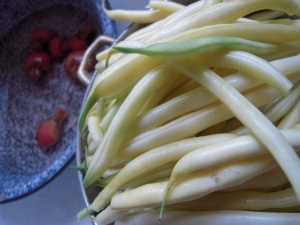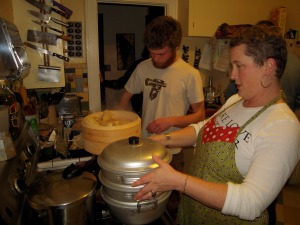You are currently browsing the category archive for the ‘digestion’ category.
Astragalus– immune stimulating (increases macrophages and natural killer cells) and adrenal tonic. great for anyone with spleen qi deficiency, supports good digestion. Very safe, mildly sweet flavor, overall tonifying.
Burdock root- Liver tonic, blood cleanser, alterative. Mildly bitter and therefore stimulating to the digestive system. Historically used for hormone balancing and skin conditions.
Dandelion Root- Alterative, liver tonic, nutritive. Wonderful for detoxification and elimination processes.
Licorice Root-Anti viral, immune modulating, adrenal tonic. Sweet flavor. Used to treat colds, coughs, stomach upset, chronic fatigue. (caution in high doses if you have high blood pressure)
Codonopsis – Also known as Dangshen, or poor man’s ginseng. Used to increase resistance to stress, increase energy, modulate immune response (increase response in cancer, decrease in autoimmune conditions).
Ginger– potent anti-inflammatory, antioxidant, anticancer, carminative (good for nausea, gas, dyspepsia). Warming.
Cinnamon-wow, a powerhouse of health benefits! Anti-inflammatory (great for arthritis pain and menstrual cramps), antimicrobial, promotes healthy blood sugar and insulin sensitivity, can promote healthy cholesterol levels. Warming and delicious!
Black Peppercorns– Helps with digestion, is antioxidant and antimicrobial.
Cloves-Pain relief, high in antioxidants, antibacterial, digestive stimulant.
The amount of herbs pictured (I’m bad about measuring things, but you can see it’s a tablespoon or two of each herb) made one gallon of chai. Simmer the herbs for 45 minutes to an hour, add black tea and steep for 4 minutes. Strain. You can keep this mixture in the fridge for a week, heating up one cup at a time. Add cream and honey to taste. You might not need to add any honey as some of the herbs are quite sweet.
I recommend drinking super tonic chai daily to build strong adrenals, and keep your immune system healthy!
More and more research is supporting the idea that inflammation is at the heart of most chronic diseases.
A wonderful friend of mine taught me this delicious recipe for an anti-inflammatory tea. She experienced significant reduction in her arthritis pain after regular consumption. I decided I had to try it myself! Not only is it extremely good for you, it is delicious!
Recipe? In a saucepan full of water throw a few slices of fresh ginger, fresh turmeric, and cinnamon sticks. Simmer for 20 min or longer. Add a small bit of honey and the juice of one lemon. Drink hot or cold! It is also easily made with dried, ground herbs as well. Try 1 quart of water with 1/2 tsp of each herb.
Curcumin, the potent anti-oxidant in Turmeric has been found to be as effective an anti inflammatory as prescription non-steroidal anti-inflammatory drugs in a trial with rheumatoid arthritis patients. It is an effective free radical scavenger, and holds promise in prevention of cancer and alzheimer’s disease. In nutrition, it seems that the deeper the color of the food the higher the nutritional value. So when you are shopping, look for deep green greens like kale, dark berries, and bright yellow pigments like turmeric for nutrient dense power.
Ginger has been used traditionally to quell arthritis pain and has been shown effective in trials comparing it to NSAIDS. Ginger is also a warming, digestive stimulant.
Cinnamon is rapidly earning its reputation as a blood sugar and lipid regulator for folks who struggle with insulin resistance and type 2 diabetes. Besides this, cinnamon is also anti-inflammatory, anti-parasitic, warming and delicious!
Do you need any more encouragement to go put on a pot of water for a batch of turmeric, ginger, cinnamon tea?
I need a little correction after the holiday weekend. How about you?
Into the vitamix today went:
1 small beet (liver food)
a handful of dandelion greens (good diuretic and bitter greens for liver/gallbladder stimulation)
1 cup kombucha (probiotics, tangy deliciousness)
1/2 cup frozen cranberries (great for kidney flush, and high in anthocyanins)
1/2 cup frozen blueberries (what are blueberries NOT good for?)
fresh ginger (anti-inflammatory, digestive stimulant)
2 T ground flax seeds (high in lignans, soluble fiber, and omega 3 fatty acids which are anti-inflammatory)
1 tsp ground milk thistle (liver and kidney tonic)
2 cups water

Zydeco Beans
Last night sitting on the back patio at a friends house, we engaged in a lively discussion of the meaning of the word “penultimate”. It means “second to last.” It got interesting though when you consider our negative connotation of “last.” We don’t think of coming in last as the “ultimate” do we? I liked the analogy that Holly brought up: Think of climbing a mountain. The last part is the peak, the highest part, the goal, the… ultimate. In the Tour de France, Philip pointed out, the penultimate stage is the second to the last stage. What does this have to do with pickles you may be asking yourself? Those who know me well, know that I have been a bit fascinated with pickling things for quite some years now. Before medical school I used to spend my summers canning and pickling, but in the busy years of school I have discovered the blessed “quick” pickle. And believe me they are a blessing. The are so easy to make. Last christmas I made a bunch of pickles for a party and Sadie said I needed to write a “Pickle Manifesto” for my blog. I have been thinking about that ever since. Writing a manifesto is just too big of an assignment for me. That’s why I have a blog instead of a cookbook. Also too big. My life is very busy. I just barely have enough time for a quick pickle and a short blog post. Therefore, consider this my penultimate pickle manifesto, and be pleasantly surprised, but don’t hold your breath for the ultimate pickle manifesto to be written.
Do pickles have health benefits? There are many health benefits of traditionally fermented pickles. Fermented foods are a great way to increase the beneficial flora in our digestive systems. The quick pickles that I have been making are not fermented however, they are bathed briefly in vinegar and spices. I find that they are a delicious way to eat more vegetables, which has to be a good thing! I speculate also that if pickles were eaten before meals, the vinegar would stimulate the production of digestive enzymes which primes the stomach to be able to digest the upcoming meal.
One of my favorite pickle cookbooks is by Chris Schlesinger and John Willoughby, Quick Pickles: Easy Recipes with Big Flavor, and lately I have been using The Joy of Pickling by Linda Ziedrich, which is chock full of every kind of pickle recipe you could imagine.
Just to illustrate my pickle crazed state, I confess I spent yesterday in 100 degree Oregon weather canning pickled beans. I was dripping with sweat, but happy. Here is the recipe, adapted from The Joy of Pickling:
Zydeco Beans
3 pounds yellow wax beans trimmed to fit into a pint canning jar
6 garlic cloves, 6 fresh serrano peppers, 6 dill heads, 6 teaspoons brown mustard seeds
31/2 cups white wine vinegar
31/2 cups water
2 tablespoons sea salt or kosher
Into each of 6 clean pint jars, put a garlic clove, pepper, dill head, and teaspoon of mustard seeds. Pack the beans vertically into the jars fitting as many as you can in each jar. 
In a saucepan, bring the vinegar, water and salt to a boil. Pour the hot vinegar mixture over the beans, leaving 1/2 inch headspace. Close the jars with two piece caps. Process the jars for 5 minutes in a boiling water bath.
Store the cooled jars for at least 3 weeks before eating them. Store in the refrigerator after opening.

Wax beans
Some folks need to be convinced that cooking for ourselves is worth it. In my blog I am interested in exploring all aspects of nourishment. Cooking is a very nourishing act we can do for ourselves or for others. I hope to explore this topic from different angles over time, so check back for future installments of Reasons to Cook!
We all have heard the expression “You are what you eat.” This is true in the sense that you can’t build strong bones, blood vessels and tissues without the nutritional building blocks from healthy food. But I would ask you to consider for a moment that in truth we are what we absorb! Many of us have healthy diets but poor digestion. How can we get the most out of our food?
Did you know that digestion actually begins in the brain? It is called the “cephalic phase” of digestion. It refers to our brains anticipating that a good meal is coming and preparing our bodies for digestion. This is one very good reason to cook meals at home. The process of preparing the food and the smell of the food cooking, all prime the body for optimal digestion! So get back to basics! Cooking for ourselves is an empowering act of creating health.





